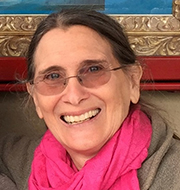 As Executive-in-Residence at IMD, I am building on my decades of experience facilitating for clients from all sectors globally my trademark process of stategic relational engagement (SRE™) of stakeholders. I am focusing on the strategic position of value creation and competitiveness through SRE. I am distilling and synthesizing key teachable lessons for leaders who participate in IMD executive education programs . I am developing essential guidelines for practical applications in various contexts. These include internal stakeholder applications for boards and senior management whether horizontal across function or vertically in direct reports; external stakeholders whether customers, suppliers or willing partners; and more complex potentially adversarial external stakeholders (i.e.: activist shareholders, government regulators, NGOs and other civic groups, etc).
As Executive-in-Residence at IMD, I am building on my decades of experience facilitating for clients from all sectors globally my trademark process of stategic relational engagement (SRE™) of stakeholders. I am focusing on the strategic position of value creation and competitiveness through SRE. I am distilling and synthesizing key teachable lessons for leaders who participate in IMD executive education programs . I am developing essential guidelines for practical applications in various contexts. These include internal stakeholder applications for boards and senior management whether horizontal across function or vertically in direct reports; external stakeholders whether customers, suppliers or willing partners; and more complex potentially adversarial external stakeholders (i.e.: activist shareholders, government regulators, NGOs and other civic groups, etc).
Companies know they must engage their internal stakeholders and there is a huge body of data about how engaged employees and engaged customers have a positive effect on bottom-line as well as the converse. We are in an increasingly connected world where traditional boundaries shift by the hour driven by globalization, readily available information – accurate or not – and a 24/7 news cycle. So the impact on business bottom line of not just traditional but also non-traditional, non-market stakeholder – those we have by decision or default – has become more critical: SRE of such stakeholders is no longer an option but an imperative. Companies understand that a broader spectrum of external stakeholders than ever before has a direct impact on their core business whether the company has chosen, cares about, likes them or not.
A complex multi-dimensional matrix of factors is necessary to create and sustain SRE of stakeholders, which I am mapping out. I continue to dive deeper into each component as a teachable lesson, untangling the interconnected elements to uncover what’s key for success. I have divided this complex inter-related matrix into four core topics: (I) How to Create Value through SRE; (II) How to Overcome Obstacles in Creating SRE; (III) How to Make SRE Last once its created; and (IV) Why the Role of Bridging Leaders is vital in SRE. With feedback from my IMD colleagues and the executives we interact with, I am reviewing each core topic and diving deeper into each of its sub-components as teachable lessons. While I rely heavily on the thousands of concrete real-life examples I draw on from almost four decades of experience, I also am utilizing empirical data, case studies and professional papers to bring to life each lesson on how executives from different fields can adapt practical applications for their own success in creating and sustaining SRE with their internal and/or external stakeholders. But, it’s really the stories that bring to life my presentations.
For example, within How To Create Value – including the conditions, qualities and processes required – I am sharing stories about several multi-sector partnerships I helped create, two of which are: (1) Weyerhaeuser, Tree People and CA government on renewable resource as example that worked and sustained; and (2) Unilever, UNICEF, India government on child nutrition as example that started with strong potential but didn’t fulfil its ambition of scale. I also am sharing stories about internal alignment of board management stakeholders around organization mission including those for which SRE worked like an international UK-based NGO and those that didn’t work like a Nigerian-based pharmaceutical company.
To explicate the sub-component elements of my other three core SRE topics: II obstacles, the drivers to overcome them and how to mobilize these drivers; III how to sustain it, how it can break down and how to mend those breaches; IV key role of bridging leaders at each stage and in each situation based on specific work I’ve done in Asia, Europe, the Middle East, the Americas and Africa I am sharing stories about internal and external SRE. These include work with leaders at Omnicom Group, The Coca Cola Company and other multi-nationals as well as my comparable SRE work with foundations, non-profits and governments throughout the world, sometimes for a single entity and sometimes with two or more entities trying to work together.
My work shows that: (1) high performance bridging leaders – or, über-catalytic drivers –facilitate creating and sustaining SRE; (2) there are teachable frameworks for bridging leaders to create and sustain SRE; and (3) utilizing SRE exponentially improves organizations’ bottom line and achieves great outcomes. We are exploring myriad sub-components that are practical take-away applications that allow executive leaders to know what they can do now to employ SRE best practices to create value and be competitive.
You may wonder about my title for this post so here’s a short personal history to put it in context. From the time I was a very young woman, I was enthralled by Martin Buber’s I and Thou (Ich und Du, 1923), which presents a philosophy about how human existence may be defined by the way in which we engage in dialogue with each other. According to Buber, in the I-Thou relationship, we do not perceive each other as consisting of specific, isolated qualities, but engage in a dialogue involving each other’s whole being. When I was exposed to the South African concept of Ubuntu, which is that to be human is to affirm one’s humanity by recognizing the humanity of others and, on that basis, establish respectful human relations with them. I firmly believe South Africa emerged from apartheid not only because Nelson Mandela embodied restorative rather than retributive justice but also because Ubuntu was so central to the national psyche that people could accept his call for that. As a student involved in the American civil rights movement, Dr Martin Luther King Jr’s “I Have a Dream” speech in Washington, DC was an especially pivotal moment in my life. I was riveted by his message and particularly moved by his concept of the Beloved Community.
Throughout my personal life and my professional career, I have been a bridge-builder who was guided by these and similar philosophic views that turned on the central importance of relationships. In my family, I have helped disparate members cohere into an extended circle of extended connected relationship that transcended blood ties. In my work, I have helped countless individuals and organizations to work in collaborations where the whole was always greater than the sum of the parts. So, I have experienced how the concepts of I/Thou, Ubuntu and Beloved Community actually do work in business and to great effect!
If you are interested in seeing the outlines of articles I’m working on or power point presentations I’m creating to share these lessons, please let me know through comments on this post. As important, if you have insights about the value, limits, challenges and ultimate benefits of knowing exactly who are your key internal and external stakeholders and how best to engage them, I welcome your input and encourage you to provide hyper-links to your work in your comments. This article was initially published on ReWiring Business on Jan 27, 2011: you may also post comments on that site.

